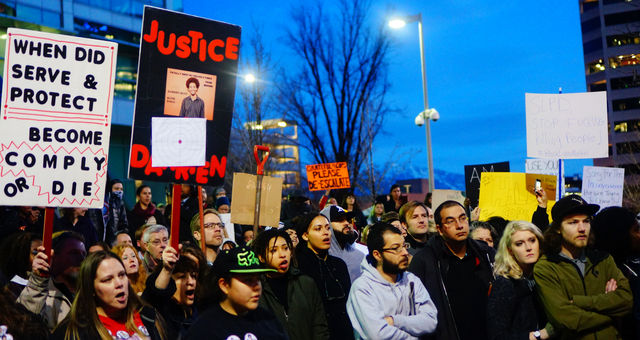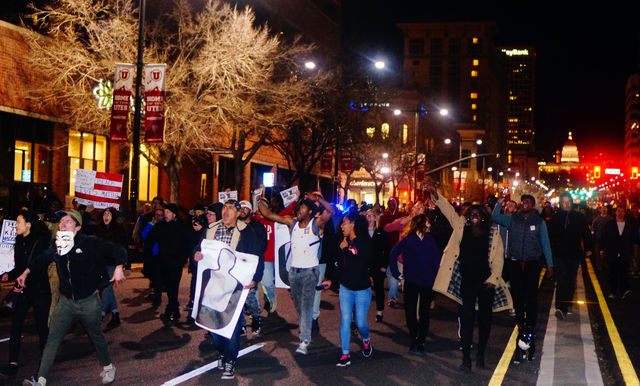
Rishi Deka, Daily Utah Chronicle
People at the Bennett Federal Building at the Utah Against Police Brutality rally and march for Abdi Mohamed in dowtown Salt Lake City, Utah on Monday, Feb.29th, 2016. (Rishi Deka, Daily Utah Chronicle)
Our beliefs and values shape the way we look at the world and the way we treat it. Unfortunately, our paradigm of normal has exempted accountability for those who hold positions of power. When we give a person a badge and gun, we allow ourselves to be subjugated under the guise that we are offered safety and protection in return for our subordination. But this exchange has yielded up power that is not appropriately checked, and it left 17-year-old Abdi Mohammed critically injured after he was shot twice by police officers in downtown Salt Lake City on Friday, Feb. 27.
We are getting too used to this narrative: another unarmed, black teen was shot by police officers. Racism these days is tricky to pinpoint because it’s no longer an individual act of cruelty and prejudice. It exists within our institutions, and white privilege is too often unacknowledged. The Black Lives Matter movement and protests after officer-involved shootings are aimed at exposing this institutional racism, which only becomes visible in this extreme form of public upheaval. The protests go beyond incidents of black teens getting killed by police officers.

Even though most people do not identify as inherently racist, research in the fields of social psychology and neuroscience reveals that people who say they believe in equality and fairness still “show significant patterns of bias” according to David Amodio and other neuroscientists at New York State University. The amygdala, which is linked to fear responses inside the brain, show that a plurality of white people react fearfully to seeing pictures of black males.
Cognitive dissonance allows our psyche to justify the shootings and maintain the status quo. We often victim-blame and justify the acts rather than looking at the situation as a whole. In this event, we rationalize the shooting of a child because “Abdi did not put down the broomstick/pipe when officers instructed.” But officers are trained to de-escalate situations. The deeper we delve into the social and economic disadvantages Abdi faced, coupled with the sad but illuminating fact that black males are 21 times more likely to be shot by police than their white counterparts, we must face the situation for what it is. We must recognize and condemn this injustice before we can rectify it.
Part of what makes race so hard to talk about is that it poses serious challenges to the status-quo. Changes to racist structures in our urban environments as well as our natural environments would threaten the existence of its profiteers. We like to think that the outcomes of our life, including success or failure, are entirely dependent upon the life choices we make and the work we put in. Good choices generally lead to good things and bad choices will get you shot by police officers — or so the popular narrative goes. This flawed perspective leads people to assume their life achievements are wholly a consequence of the choices they made. We should recognize there are systems in place that are tipping the balance against the poor and against minorities.
